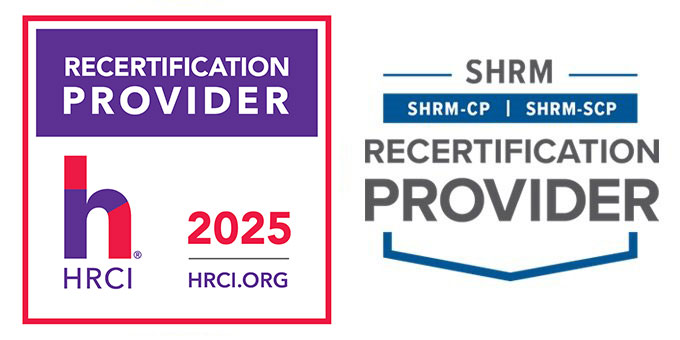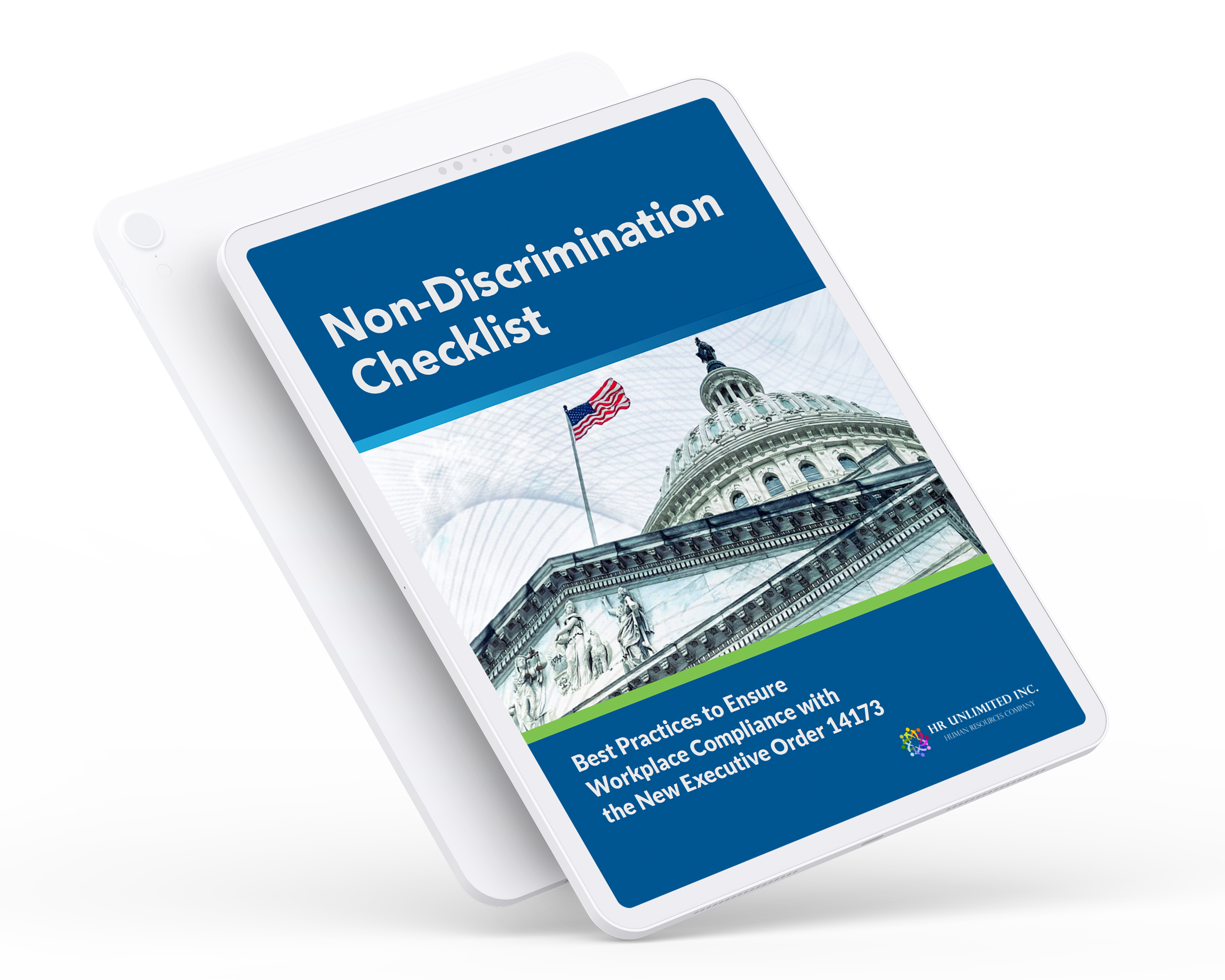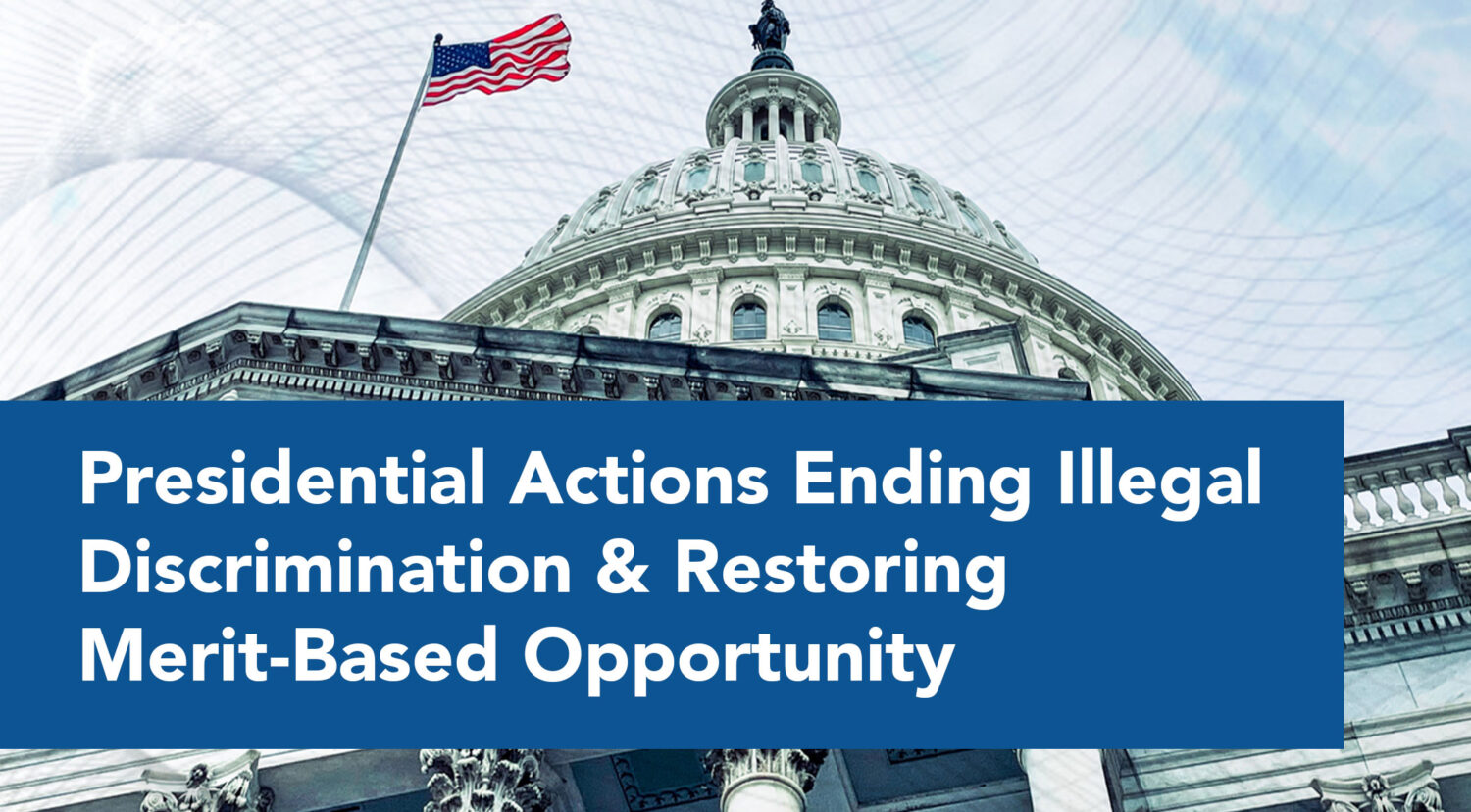

By Sandra Hueneman, SR CAAP, President Manchester Consultants
On January 21, 2025, President Trump revoked Executive Order 11246, whereby the Office of Federal Contract Compliance Programs within the Department of Labor shall immediately cease:
- Promoting “diversity”
- Holding Federal contractors and subcontractors responsible for taking “affirmative action;” and
- Allowing or encouraging Federal contractors and subcontractors to engage in workforce balancing based on race, color, sex, sexual preference, religion, or national origin.
On January 24, 2025, the Acting Secretary of Labor issued Secretary’s Order 03-2025, whereby the US Department of Labor to cease and desist all investigative and enforcement activity under rescinded Executive Order 11246.
President Lyndon B. Johnson signed Executive Order 11246 on September 24, 1965. Executive Order 11246, established requirements for non-discriminatory practices in hiring and employment and required contractors to “take affirmative action to ensure that applicants are employed, and that employees are treated during employment, without regard to their race, creed, color, or national origin.” Over the years, the Executive Order 11246 was modified to include federal subcontractors, in addition to added protection to gender identity and sexual orientation.
A review of the implementing regulations governing EEO and affirmative action obligations 41 CFR § 60, and this order signed January 21, 2025, it is apparent there is much confusion on what affirmative action is and what it is not.
41 CFR § 60-1.1 The purpose of the regulations in this part is to achieve the aims of parts II, III, and IV of Executive Order 11246 for the promotion and insuring of equal opportunity for all persons, without regard to race, color, religion, sex, sexual orientation, gender identity, or national origin, employed or seeking employment with Government contractors or with contractors performing under federally assisted construction contracts.
In accordance with the Equal opportunity clause 41 CFR § 60-1.4 requires
Contractors and subcontractors entering federal contracts and subcontracts agree to comply with the EEO clause during the performance of this contract:
(1) The contractor will not discriminate against any employee or applicant for employment because of race, color, religion, sex, sexual orientation, gender identity, or national origin. The contractor will take affirmative action to ensure that applicants are employed, and that employees are treated during employment, without regard to their race, color, religion, sex, sexual orientation, gender identity, or national origin. Such action shall include, but not be limited to the following: Employment, upgrading, demotion, or transfer, recruitment, or recruitment advertising; layoff or termination; rates of pay or other forms of compensation; and selection for training, including apprenticeship. The contractor agrees to post in conspicuous places, available to employees and applicants for employment, notices to be provided by the contracting officer setting forth the provisions of this nondiscrimination clause.
The regulations do not require preferences for any group except preference in employment to Indians living on or near an Indian reservation 41 CFR § 60-1.5.
In accordance with 41 CFR § 60-2.10, An affirmative action program is a management tool designed to ensure equal employment opportunity. A central premise underlying affirmative action is that absent discrimination, over time a contractor’s workforce, generally, will reflect the gender, racial and ethnic profile of the labor pools from which the contractor recruits and selects. Affirmative action programs contain a diagnostic component which includes a number of quantitative analyses designed to evaluate the composition of the workforce of the contractor and compare it to the composition of the relevant labor pools. Affirmative action programs also include action-oriented programs. If women and minorities are not being employed at a rate to be expected given their availability in the relevant labor pool, the contractor’s affirmative action program includes specific practical steps designed to address this underutilization. Effective affirmative action programs also include internal auditing and reporting systems as a means of measuring the contractor’s progress toward achieving the workforce that would be expected in the absence of discrimination.
When there is a need to establish a placement goal under 41 CFR § 60-2.16, it is important to understand the purpose of placement goals and how achievement is measured. Such goals are based upon the availability of where, how the contractor fills vacancies and considers those from such areas with the skills, knowledge, and abilities to perform the job.
(a) Purpose: Placement goals serve as objectives or targets reasonably attainable by means of applying every good faith effort to make all aspects of the entire affirmative action program work. Placement goals also are used to measure progress toward achieving equal employment opportunity.
(b) A contractor’s determination under § 60-2.15 that a placement goal is required constitutes neither a finding nor an admission of discrimination.
(c) Where, pursuant to § 60-2.15, a contractor is required to establish a placement goal for a particular job group, the contractor must establish a percentage annual placement goal at least equal to the availability figure derived for women or minorities, as appropriate, for that job group.
(d) The placement goal-setting process described above contemplates that contractors will, where required, establish a single goal for all minorities. In the event of a substantial disparity in the utilization of a particular minority group or in the utilization of men or women of a particular minority group, a contractor may be required to establish separate goals for those groups.
(e) In establishing placement goals, the following principles also apply:
(1) Placement goals may not be rigid and inflexible quotas, which must be met, nor are they to be considered as either a ceiling or a floor for the employment of particular groups. Quotas are expressly forbidden.
(2) In all employment decisions, the contractor must make selections in a nondiscriminatory manner. Placement goals do not provide the contractor with a justification to extend a preference to any individual, select an individual, or adversely affect an individual’s employment status, based on that person’s race, color, religion, sex, sexual orientation, gender identity, or national origin.
(3) Placement goals do not create set-asides for specific groups, nor are they intended to achieve proportional representation or equal results.
(4) Placement goals may not be used to supersede merit selection principles. Affirmative action programs prescribed by the regulations in this part do not require a contractor to hire a person who lacks qualifications to perform the job successfully or hire a less qualified person in preference to a more qualified one.
In accordance with 41 CFR § 60-2.35 – No contractor’s compliance status will be judged alone by whether it reaches its goals. The composition of the contractor’s workforce (i.e., the employment of minorities or women at a percentage rate below, or above, the goal level) does not, by itself, serve as a basis to impose any of the sanctions authorized by Executive Order 11246 and the regulations in this chapter. Each contractor’s compliance with its affirmative action obligations will be determined by reviewing the nature and extent of the contractor’s good faith affirmative action activities as required under § 60-2.17, and the appropriateness of those activities to identified equal employment opportunity problems. Each contractor’s compliance with its nondiscrimination obligations will be determined by analysis of statistical data and other non-statistical information which would indicate whether employees and applicants are being treated without regard to their race, color, religion, sex, sexual orientation, gender identity, or national origin.
OFCCP Conciliation Agreements show that OFCCP has not cited organizations for failing to take affirmative action. OFCCP has cited contractors when they do not meet the regulatory requirements outlined in 41 CFR 60-1 – 741, whether it is a technical violation or an allegation of discrimination. In addition, OFCCP has sought remedies for all groups when wrongdoing is established based upon a violation of the regulations. Following is a summary of discrimination cases completed by OFCCP between FY 2020 and FY 2024 and the groups affected and monetary relief collected. For a summary of recent cases where OFCCP seeks assistance from individuals who may have been party to such settlements. Class Member Locator Case Summary | U.S. Department of Labor. As seen by review of Conciliation Agreements, remedies are not just being sought for one group but for all groups found to have been adversely affected.
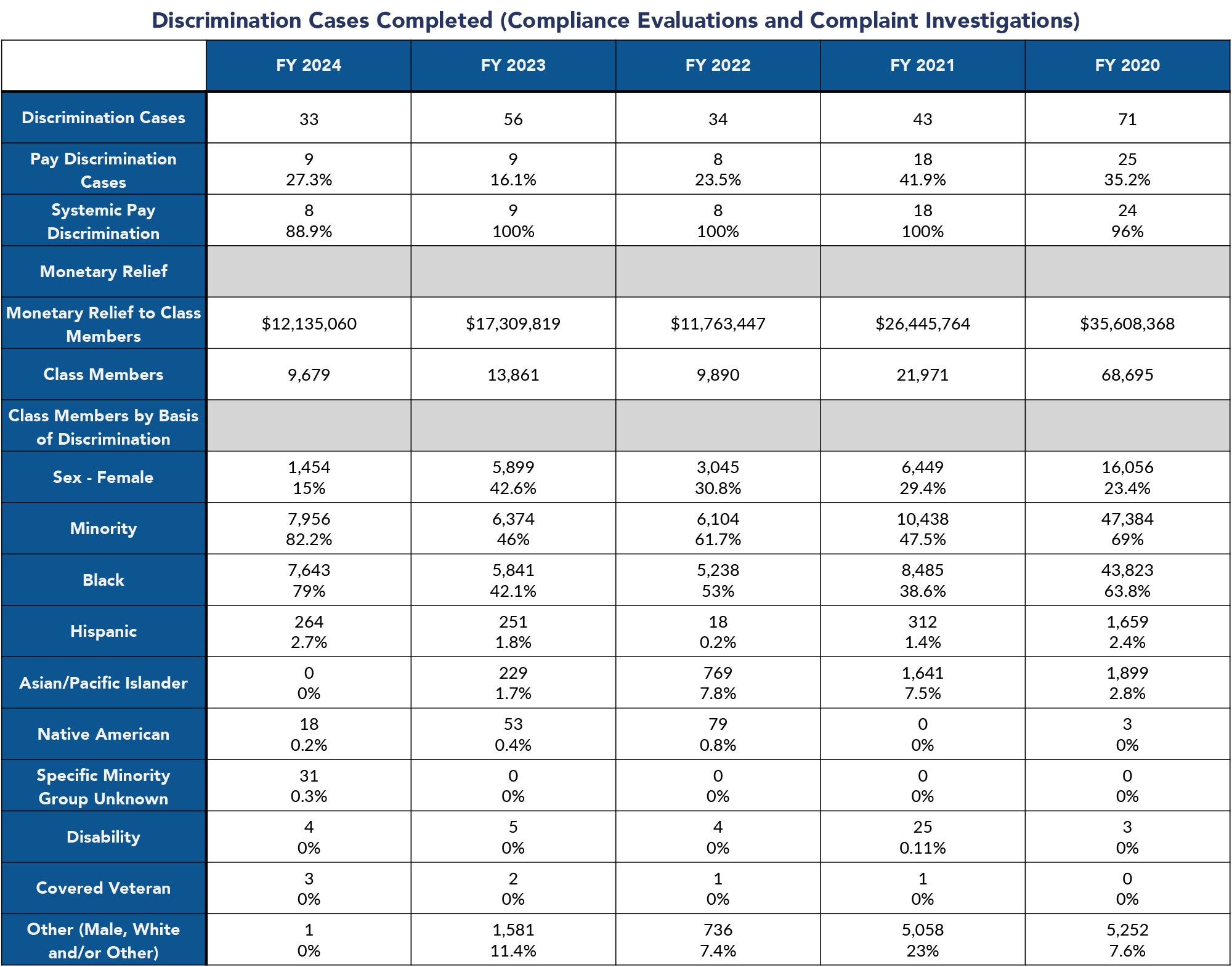
For Federal contractors and subcontractors, EEO and affirmative action efforts have increased the representation in the workplace for females and minorities, not because of one’s race or gender, but because of the EEO and affirmative action (positive action) efforts by taking outreach and recruitment efforts to which federal contractors have done when it is determined they have not tapped into potential candidates who have the skill, knowledge and ability to do the job based upon how and where the jobs are filled from the area(s) they recruit, not because of prohibited factors such as race and/or gender.
Following is a comparison of the EEOC EEO-1 Surveys from 1966 as compared to 2022, the most recent stats available as of this writing. The biggest change for all groups occurred in 2006.
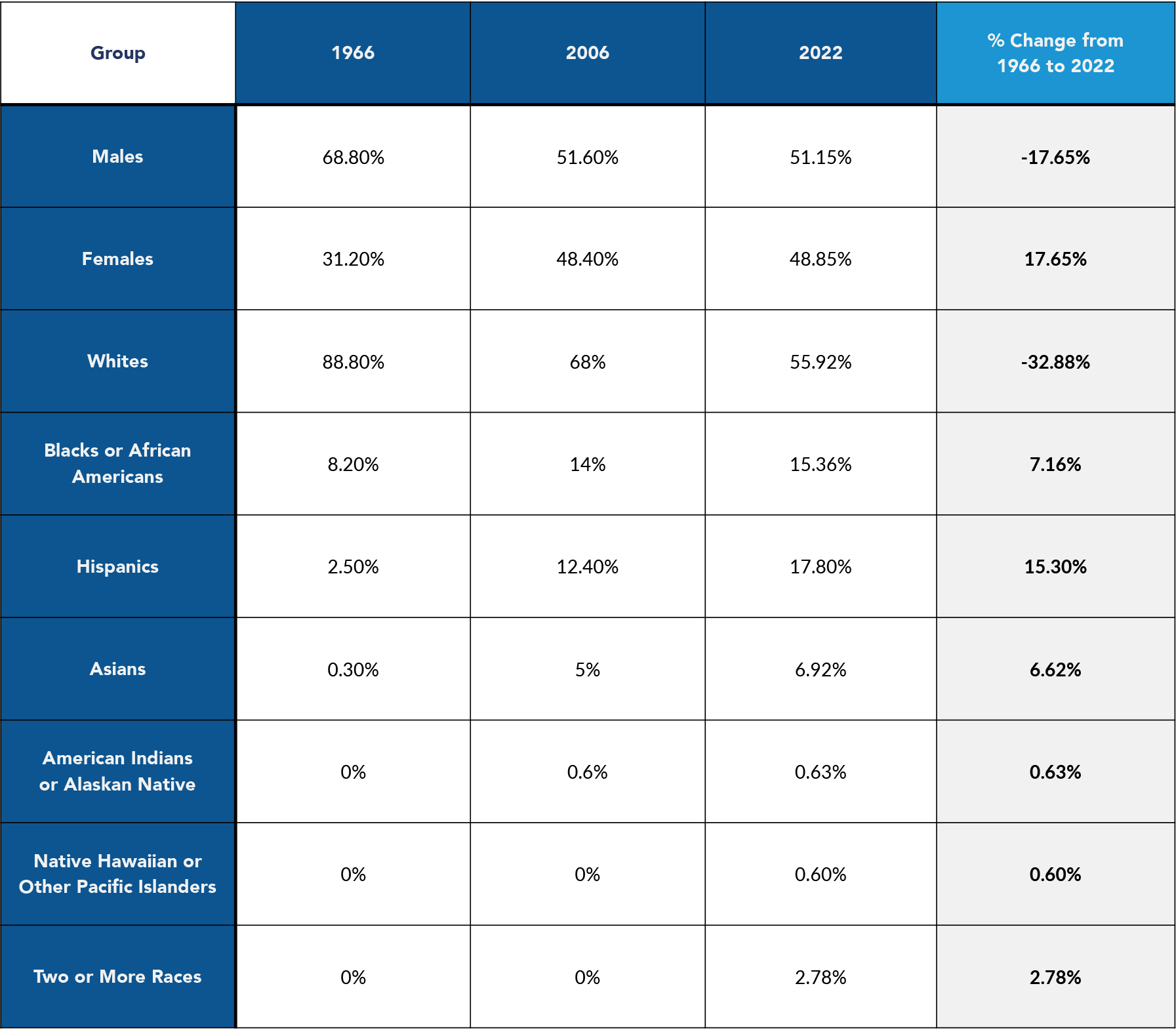
We cannot manage what we do not measure, nor can we certify that we do not employ discriminatory practices if we have not measured the impact of our employment practices. Organizations can have policies and procedures created with the best intentions to ensure non-discrimination, however, if not implemented and measured to determine their effect on employment decisions, we cannot certify we employ non-discriminatory practices. As a best practice, we highly recommend employers consider using appropriate analytical tools and assessments, mock EEO audits, so that there is certainty when there is a need to certify that your organization does not operate any programs promoting DEI programs or processes that violate applicable Federal anti-discrimination laws. Best practice is not to wait until there is a complaint or an allegation of wrongdoing!
HR Unlimited, Inc. specializes in helping federal contractors and employers effectively meet their HR compliance obligations. Please contact us to discuss any of your questions, concerns, or needs in this area.


